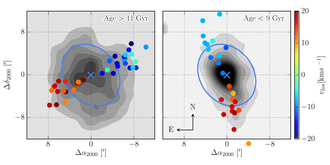
The Andromeda II dwarf galaxy is a companion of M31, one of a few tens of known dwarf galaxies in the Local Group. It is relatively bright, spheroidal and its stellar content can now be studied in detail even at its large distance of 650 kpc. The galaxy is known to possess at least two stellar populations, different not only in age, but also in their chemical composition and spatial distribution along the body of the galaxy. Recent studies have also revealed a strong rotation signal, which is not at all common in this type of objects. What is even more intriguing, the galaxy rotates around its optical major, rather than minor, axis.
Andrés del Pino and collaborators from Copernicus Center and Instituto de Astrofisica de Canarias studied the photometric and kinematic properties of the galaxy’s stars using new analysis techniques. They demonstrated for the first time that the two stellar populations are also separated in their kinematics. The figure shows the two stellar populations: the one on the left is composed of stars older than 11 billion years while the one on the right is formed by stars with ages between 9 and 6 billion years. Their distribution is traced by the grey contours. Stars with known velocities and belonging to these populations are shown using coloured points. The colour scale indicates their line-of-sight velocities with respect to Andromeda II showing significant rotation. A clear segregation can be seen in the distribution, age and kinematics of the stars.
All these unusual features can be explained if the galaxy formed as a result of a merger of two disky galaxies of similar mass that collided around 10 billion years ago. The compression of the gas remaining in the two galaxies during the merger would have restarted the star formation in the remnant galaxy. This could give rise to the two distinct populations.
The results were obtained as part of the project “Dynamics and morphology of interacting galaxies” funded by the National Science Centre within the Maestro program. The article “The structure of Andromeda II dwarf spheroidal galaxy” describing these findings has been submitted for publication in MNRAS. Read the paper.






